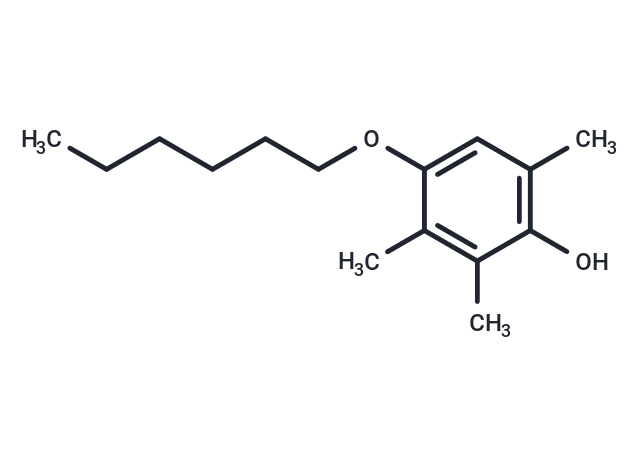Shopping Cart
- Remove All
 Your shopping cart is currently empty
Your shopping cart is currently empty
HTHQ (HTHQ(1-O-Hexyl-2,3,5-trimethylhydroquinone)), a hydroquinone monoalkyl ether, is an effective anti-oxidative agent. HTHQ is a potent anti-lipid-peroxidative compound and its antioxidation activity to be extremely elevated in biological systems, such as that of liver microsomes via the generation of stable free radicals.

| Pack Size | Price | Availability | Quantity |
|---|---|---|---|
| 10 mg | $37 | In Stock | |
| 25 mg | $58 | In Stock | |
| 50 mg | $77 | In Stock | |
| 100 mg | $97 | In Stock | |
| 200 mg | $158 | In Stock | |
| 1 mL x 10 mM (in DMSO) | $40 | In Stock |
| Description | HTHQ (HTHQ(1-O-Hexyl-2,3,5-trimethylhydroquinone)), a hydroquinone monoalkyl ether, is an effective anti-oxidative agent. HTHQ is a potent anti-lipid-peroxidative compound and its antioxidation activity to be extremely elevated in biological systems, such as that of liver microsomes via the generation of stable free radicals. |
| In vitro | HTHQ has an anti-oxidative activity similar to D,L-alpha-tocopherol against lipid peroxidation in linolate micelles initiated by addition of Fe2+. The anti-lipid-peroxidation activity of HTHQ is higher 4.8-fold than that of D,L-alpha-tocopherol against the peroxidation in phosphatidylcholine liposomes initiated by addition of Fe2+. [1] The effects of 0.02% Glu-P-1 or 0.03% MeIQx on the number and area of foci is significantly reduced by 0.125% HTHQ. [2] |
| In vivo | Treatment with HTHQ potently inhibits PhIP-induced mammary carcinogenesis in female rats. Compared with DMN-induced hepatic fibrosis animals in the liver tissue, HTHQ reduced mRNA level of PDGF (Platelet-derived growth factor), α-SMA (α-smooth muscle actin) and TGF-β (transforming growth factor-β). In this study, we showed that HTHQ improves against DMN-induced liver fibrosis in male SD rats. |
| Synonyms | HX 1171, HTHQ(1-O-Hexyl-2,3,5-trimethylhydroquinone), 1-O-hexyl-2,3,5-trimethylhydroquinone |
| Molecular Weight | 236.35 |
| Formula | C15H24O2 |
| Cas No. | 148081-72-5 |
| Smiles | CCCCCCOc1cc(C)c(O)c(C)c1C |
| Relative Density. | 0.971 g/cm3 (Predicted) |
| Storage | Powder: -20°C for 3 years | In solvent: -80°C for 1 year | Shipping with blue ice/Shipping at ambient temperature. | |||||||||||||||||||||||||||||||||||
| Solubility Information | DMSO: 43 mg/mL (181.93 mM), Sonication is recommended. | |||||||||||||||||||||||||||||||||||
Solution Preparation Table | ||||||||||||||||||||||||||||||||||||
DMSO
| ||||||||||||||||||||||||||||||||||||

Copyright © 2015-2025 TargetMol Chemicals Inc. All Rights Reserved.